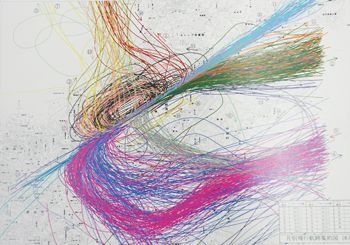MCAS Futenma 2018 air traffic survey results show that established flight path deviations are becoming the norm

Flight paths of U.S. aircraft flying out of MCAS Futenma – August 9, Okinawa Defense Bureau
August 10, 2019 Ryukyu Shimpo
(Chubu) The Okinawa Defense Bureau (ODB) began their 2018 inspection of a survey that tracks the flightpaths of U.S. military aircraft in the area around MCAS Futenma on August 9, run out of the ODB offices in Kadena.
After the U.S. military helicopter crash at Okinawa International University in 2004, Japan and the U.S. revised the flight plans for aircraft in 2007, plotting courses that avoided flying over civilian areas as much as possible.
The results of this year’s survey showed flight’s that strayed far off flight plans, indicating that deviations from the flight plans had become normalized.
The survey used a high-elevation camera to measure aircraft such as rotorcraft flying in the area around MCAS Futenma and construct a flight map, creating month-by-month snapshots of air traffic.
According to the results of the survey, in June of this year, the CH-53E helicopter that dropped rubber tape onto Uranishi Junior High School in Urasoe was flying over civilian airspace, and that this was a common flight path for U.S. aircraft.
Meanwhile, the ODB has established that factors such as weather can cause air craft to change course, stating, “This year’s survey results do not necessarily suggest that the U.S. military is failing to adhere to the established flight paths.”
(English translation by T&CT and Sam Grieb)
Previous Article:Protest held outside GinowanCity Hall 15 years after helicopter crash at Okinawa International University
Next Article:Traditional event Mushaama held to pray for Hateruma Island’s prosperity
[Similar Articles]
- Dangers of MCAS Futenma not limited to Ginowan, helicopter’s blade tape falls onto Uranishi Junior High
- Futenma helicopters’ routine operations significantly extended beyond limits of their flight path
- Okinawa Prefectural Assembly unanimously passes resolution calling for suspension of flights over civilian areas after accident at elementary school
- Nighttime Osprey flights double, conflicting with claims of burden reduction
- JASDF helicopter misunderstood instructions from air traffic controller at Naha Airport in June 2015
 Webcam(Kokusai Street)
Webcam(Kokusai Street)


